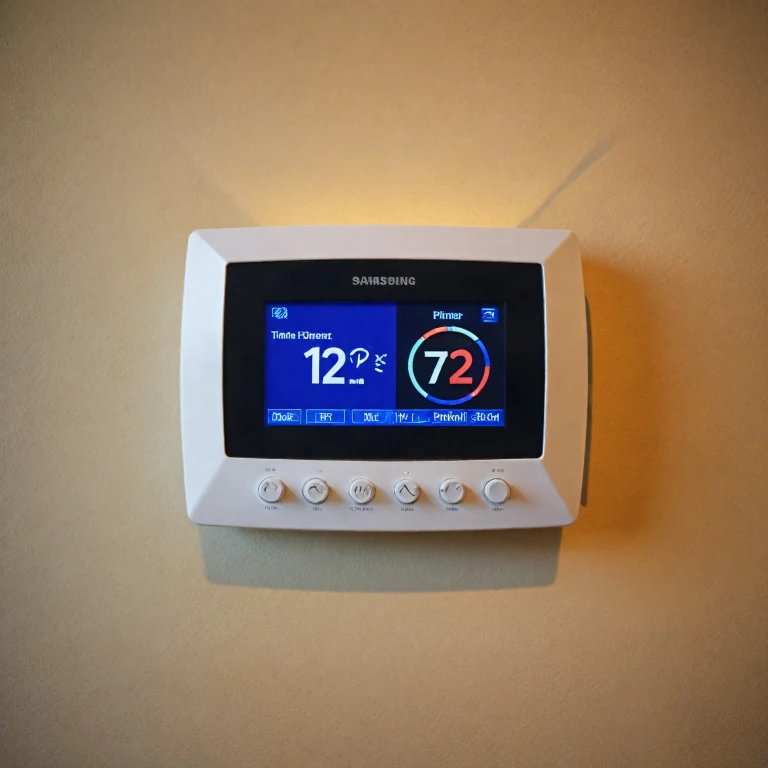What Does 'Heat Flashing' Mean?
Deciphering the Blinking Heat Indicator
When your thermostat displays a flashing or blinking light, it can be perplexing, especially if you're unsure of the underlying issue. The 'heat flashing' indicator on your thermostat usually signifies that there's a demand or request for heat from your HVAC system. Essentially, it indicates that your thermostat is communicating with the heating system to warm up your home to the desired temperature.
This blinking indicator is often a sign that the thermostat has temporarily switched off the heating to protect the HVAC system or to allow for a specific function, such as the defrost mode on a heat pump. It's important to monitor this flashing light across different circumstances. For instance, during rapid changes in outdoor temperature, you might be more likely to see this signal as your system adjusts to maintain indoor comfort.
If you find the blinking light persistent and it continues without any change in your home's temperature, it could indicate a potential issue with your HVAC system, such as a malfunctioning furnace or a false signal from the unit. In such cases, a simple reset of the thermostat might resolve the problem. For detailed instructions on resetting your Honeywell thermostat, this guide can be helpful:
how to reset your Honeywell thermostat. However, if the issue persists further, it might be necessary to consider other factors around blinking lights or to consult a professional service technician.
Common Causes of Heat Flashing
Identifying the Root Causes of Temperature Alerts
Heat flashing on your smart thermostat is a signal that something is amiss, and it's crucial to understand the potential causes to address the issue effectively. Here's a breakdown of some typical reasons that might trigger the heat flashing alert:
- Power Supply Disruptions: Your heating or cooling system may experience interruptions in power. This could be due to a tripped circuit breaker or other electrical issues.
- HVAC System Malfunctions: Any problem within the heating or cooling system, such as a malfunctioning heat pump or a blocked furnace, can cause the thermostat to flash.
- Thermostat Configuration: Incorrect thermostat settings can lead to miscommunication between the thermostat and your HVAC system, resulting in blinking lights.
- Air Filter Clogging: A dirty air filter can impede airflow, causing the system to overheat and trigger a flashing warning.
- Problems with the Outdoor Unit: Issues with the outdoor unit, like fan failure, can affect heating air effectiveness and prompt a blinking thermostat.
In some cases, troubleshooting the flashing alerts requires inspecting the thermostat and related systems physically. For more detailed guidance on addressing power issues specifically, you may find additional information by exploring
smart thermostat power troubleshooting. Remember, understanding these common causes empowers you to manage your home environment more efficiently.
Troubleshooting Heat Flashing Alerts
Steps to Address Blinking Thermostat Alerts
When your smart thermostat is emitting a blinking light signal, it might be indicating a range of issues within the thermostat itself or the larger HVAC system. Troubleshooting these alerts can often help to nip small problems in the bud before they escalate into more serious issues.
- Inspect the Circuit Breaker: Start by checking if the circuit breaker has been tripped. This can cause a power disruption in the HVAC system, leading to your thermostat blinking.
- Evaluate Thermostat Settings: Ensure that the thermostat settings are correct. A misconfigured setting could cause improper heating or cooling cycles, leading to blinking lights.
- Replace the Air Filter: A dirty air filter can lead to inefficient airflow, causing your system to blink as it fails to maintain the desired temperature. Regularly replacing the air filter can prevent many problems including heat flashing alerts.
- Check Outdoor Unit: The outdoor unit may have issues if there’s a power failure or blockage. Check if the unit is functioning correctly to rule out this common cause of thermostat flashing cool alerts.
- Diagnose Heating or Cooling Issues: A problem within the cooling system or furnace could cause the thermostat to signal a problem. Ensure these components are in prime condition by conducting regular inspections.
While these troubleshooting steps can help you address common causes of blinking lights on your thermostat, persistent issues may require professional attention. Remember that taking preventive measures can greatly reduce the occurrence of these alerts, providing a smoother operation of your HVAC system. For more depth on choosing the right thermostat for avoiding such problems, you can explore the benefits of
Mitsubishi thermostats.
When to Call a Professional
Identifying the Right Time to Seek Professional Assistance
Encountering a blinking light or heat flashing issue on your thermostat can be quite concerning. While some problems can be addressed with basic troubleshooting, there are instances where calling a professional becomes essential.
Consider reaching out to an HVAC technician in the following scenarios:
- Persistent Blinking: If your thermostat or any part of the HVAC system stubbornly continues flashing despite attempts to resolve the issue, it signals a deeper issue that requires expert analysis.
- Lack of Heat or Cooling: When the unit fails to heat or cool your home effectively and the flashing persists, a professional diagnosis may be necessary to inspect components like the furnace, heat pump, or cooling system.
- Unusual Sounds or Smells: Strange noises from the unit or odd smells emitted by the HVAC system should always prompt a professional check. They might indicate a larger problem needing immediate attention.
- Repeated Circuit Breaker Trips: If your circuit breaker trips multiple times in conjunction with the thermostat's issues, this suggests potential electrical problems that require a professional's touch.
- Inconsistencies in Temperature: If you find the temperature settings on your thermostat not matching the actual room temperature despite attempts to reset them, it could highlight an underlying issue within the HVAC or thermostat unit.
- Flashing Red or Green Lights: Often, thermostats use specific colors like red or green to indicate a significant problem. Blinking green or a flashing red light should not be ignored and should warrant a professional service call.
By recognizing these signs, you can prevent potential damage to your HVAC system and ensure your home environment remains comfortable. Keeping an eye out for the symptoms mentioned in other sections will arm you with the knowledge to address heat flashing before it evolves into a more significant problem.
Preventive Measures to Avoid Heat Flashing
Avoiding Malfunctions: Colder Temperatures Ahead
To keep your thermostat and heating system running smoothly, and to prevent the disruptive heat flashing alert, some preventive measures can be implemented. These steps aim to keep your HVAC system in good shape and ensure that blinking lights are no longer a frequent concern.
- Regular Maintenance: Schedule regular check-ups for your HVAC system. A professional can inspect the furnace, heating air, and cooling units to ensure everything is working properly.
- Inspect Thermostat Settings: Regularly review your thermostat settings to make sure they align with your optimal indoor temperature needs. Adjust settings seasonally to support the efficient operation of heating and cooling systems.
- Air Filter Checks: Change the air filter regularly, as a clogged air filter can lead to inefficiencies and potential damage to your system.
- Outdoor Unit Overview: During inspections, ensure the outdoor unit is clear of any debris. This allows for better airflow, reducing the chance of your system failing during peak usage.
- Circuit Breaker Awareness: Be aware of your home's circuit breaker settings. Sudden power surges or outages can impact your thermostat and cause the heat flashing problem to recur.
- Seek Professional Service: Before cold snaps and heatwaves, call service professionals for a thorough inspection. Identifying and fixing smaller issues early can prevent larger, costlier repairs later on.
Taking these proactive steps can minimize the chances of a blinking thermostat signal and ensure your home remains comfortably heated or cooled as needed.
Choosing the Right Smart Thermostat
Smart Choices for Intelligent Temperature Management
When dealing with a thermostat flashing issue, one critical preventive measure is choosing the right smart thermostat for your heating and cooling system. A well-matched unit ensures better communication between the thermostat, the furnace, air conditioning, and other components, minimizing potential problems like flashing green or red lights.
Consider these factors when selecting a smart thermostat:
- Compatibility with Your HVAC System: Ensure that the new thermostat is compatible with your existing HVAC system, whether it's a heat pump, central heating, or cooling system. Check the specifications to avoid any unit incompatibility issues that could lead to thermostat flashing alerts.
- Energy Efficiency Features: Look for thermostats with features designed to optimize energy usage, adjust heating or cooling based on occupancy, and offer seasonal temperature adaptations. This can prevent issues such as unnecessary power surges that cause blinking lights.
- Connectivity and App Integration: A quality smart thermostat should offer seamless smartphone connectivity for remote management. This allows you to monitor and adjust thermostat settings easily, so if a blinking thermostat indicator arises, you can troubleshoot or call for service promptly.
- User-Friendly Interface: Make sure the interface is intuitive and easy to use. A clear display and simple controls will help you check and manage settings effectively, reducing the risk of human errors that might lead to thermostat flashing problems.
- Reliable Brand and Support: Consider thermostats from reputable manufacturers with strong customer support. In case of troubleshooting needs, having access to professional service can make a difference in quickly resolving a thermostat blinking problem.
Opting for the right thermostat aids in seamless heating and cooling management, helping to prevent unnecessary issues such as flashing cool indicators or blinking heat alerts. Making an informed choice now can save future hassle and ensure optimal performance of your HVAC system.

